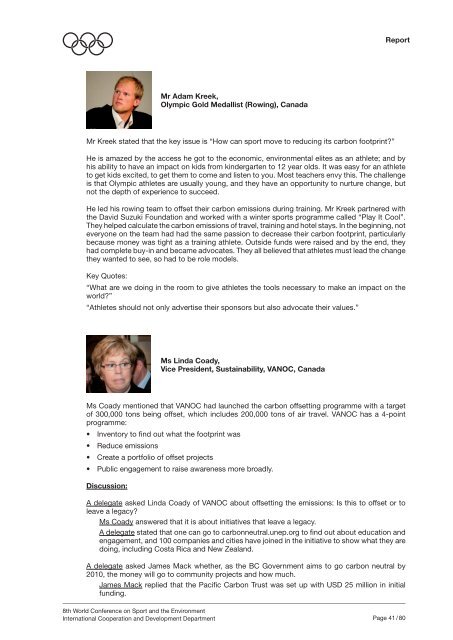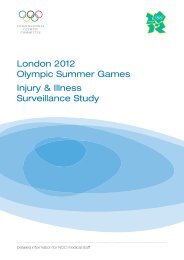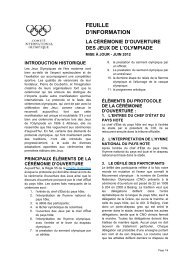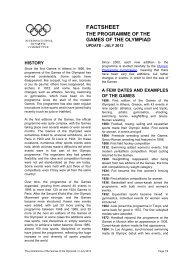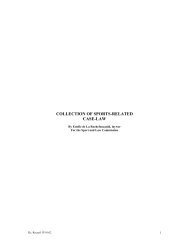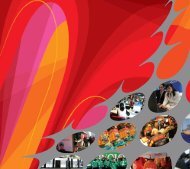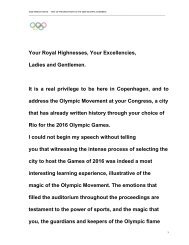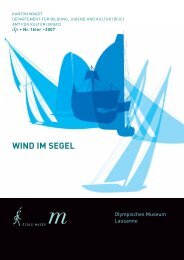8th WORLD CONFERENCE ON SPORT AND THE ENVIRONMENT
8th WORLD CONFERENCE ON SPORT AND THE ENVIRONMENT
8th WORLD CONFERENCE ON SPORT AND THE ENVIRONMENT
You also want an ePaper? Increase the reach of your titles
YUMPU automatically turns print PDFs into web optimized ePapers that Google loves.
<strong>8th</strong> World Conference on Sport and the Environment<br />
International Cooperation and Development Department<br />
Mr Adam Kreek,<br />
Olympic Gold Medallist (Rowing), Canada<br />
Mr Kreek stated that the key issue is “How can sport move to reducing its carbon footprint?”<br />
Report<br />
He is amazed by the access he got to the economic, environmental elites as an athlete; and by<br />
his ability to have an impact on kids from kindergarten to 12 year olds. It was easy for an athlete<br />
to get kids excited, to get them to come and listen to you. Most teachers envy this. The challenge<br />
is that Olympic athletes are usually young, and they have an opportunity to nurture change, but<br />
not the depth of experience to succeed.<br />
He led his rowing team to offset their carbon emissions during training. Mr Kreek partnered with<br />
the David Suzuki Foundation and worked with a winter sports programme called “Play It Cool”.<br />
They helped calculate the carbon emissions of travel, training and hotel stays. In the beginning, not<br />
everyone on the team had had the same passion to decrease their carbon footprint, particularly<br />
because money was tight as a training athlete. Outside funds were raised and by the end, they<br />
had complete buy-in and became advocates. They all believed that athletes must lead the change<br />
they wanted to see, so had to be role models.<br />
Key Quotes:<br />
“What are we doing in the room to give athletes the tools necessary to make an impact on the<br />
world?”<br />
“Athletes should not only advertise their sponsors but also advocate their values.”<br />
Ms Linda Coady,<br />
Vice President, Sustainability, VANOC, Canada<br />
Ms Coady mentioned that VANOC had launched the carbon offsetting programme with a target<br />
of 300,000 tons being offset, which includes 200,000 tons of air travel. VANOC has a 4-point<br />
programme:<br />
Inventory to fi nd out what the footprint was<br />
Reduce emissions<br />
Create a portfolio of offset projects<br />
Public engagement to raise awareness more broadly.<br />
Discussion:<br />
A delegate asked Linda Coady of VANOC about offsetting the emissions: Is this to offset or to<br />
leave a legacy?<br />
Ms Coady answered that it is about initiatives that leave a legacy.<br />
A delegate stated that one can go to carbonneutral.unep.org to fi nd out about education and<br />
engagement, and 100 companies and cities have joined in the initiative to show what they are<br />
doing, including Costa Rica and New Zealand.<br />
A delegate asked James Mack whether, as the BC Government aims to go carbon neutral by<br />
2010, the money will go to community projects and how much.<br />
James Mack replied that the Pacifi c Carbon Trust was set up with USD 25 million in initial<br />
funding.<br />
Page 41 / 80


